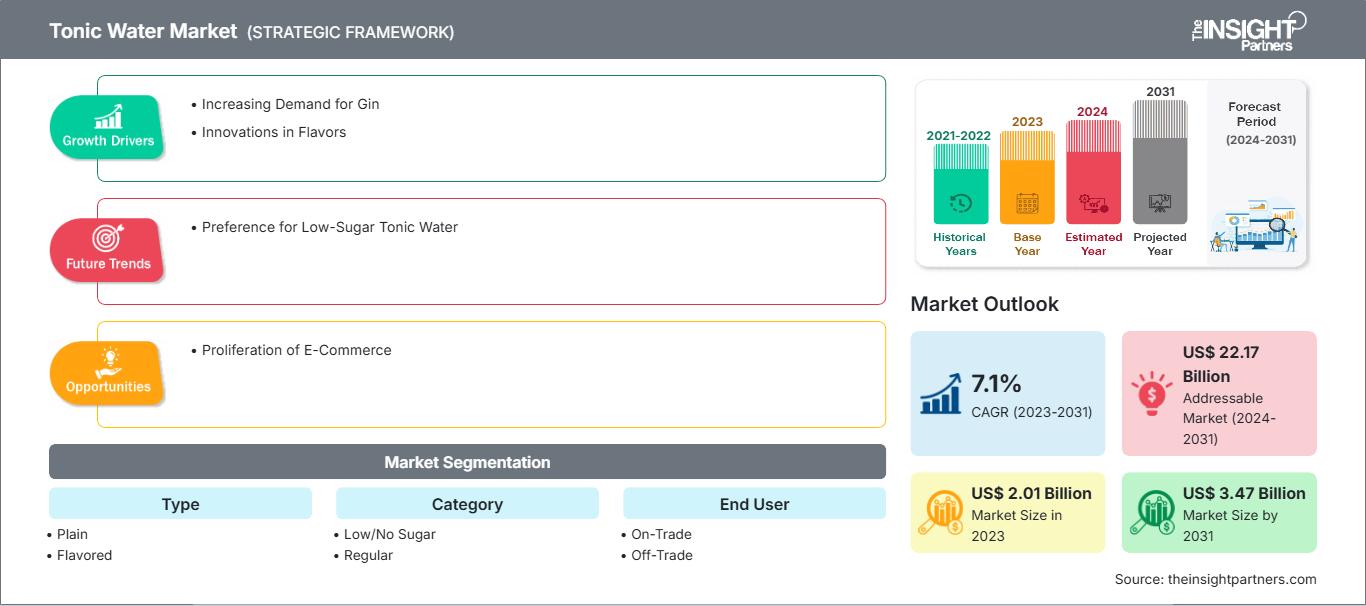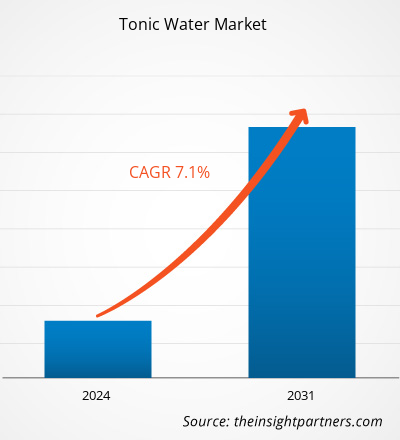Der Markt für Tonic Water soll von 2,01 Milliarden US-Dollar im Jahr 2023 auf 3,47 Milliarden US-Dollar im Jahr 2031 anwachsen. Für den Zeitraum 2023–2031 wird ein durchschnittliches jährliches Wachstum von 7,1 % erwartet. Die steigende Nachfrage nach zuckerarmem Tonic Water wird voraussichtlich ein wichtiger Markttrend bleiben.
Marktanalyse für Tonic Water
Der zunehmende Gin-Konsum ist einer der Hauptfaktoren für das Wachstum des Tonic Water-Marktes. Innovationen bei den Aromen von Tonic Water helfen den Herstellern, die Verbraucher mit aufregenden Geschmacksprofilen zu begeistern. Darüber hinaus wird erwartet, dass die Expansion des E-Commerce dem Tonic Water-Markt zahlreiche Möglichkeiten bietet, innovative Produkte zu entwickeln, zu wachsen und sich wandelnde Bedürfnisse zu erfüllen.
Marktübersicht für Tonic Water
Tonic Water ist ein kohlensäurehaltiges Erfrischungsgetränk, das hauptsächlich als Mixer oder Basis für Gin, Wodka und andere Spirituosen verwendet wird. Es ist in einer breiten Palette von Geschmacksrichtungen wie Waldbeere, Holunderblüte und Bitterzitrone erhältlich. Mit dem sich ändernden Lebensstil der Menschen und der zunehmenden Vorliebe für Premiumgetränke steigt die Nachfrage nach Tonic Water in den USA, Indien, Japan, Australien, Großbritannien, Spanien und Italien sowie in anderen Industrie- und Entwicklungsländern deutlich an. Die Menschen in diesen Ländern entdecken gerne neue Erfahrungen und Geschmäcker, was die Nachfrage nach Tonic Water steigert. Darüber hinaus führt der zunehmende Trend zur Cocktailkultur und zu nächtlichen Partys unter der Generation Z und der Millennials ebenfalls zu einer erhöhten Nachfrage nach Tonic Water.
Passen Sie diesen Bericht Ihren Anforderungen an
Sie erhalten kostenlos Anpassungen an jedem Bericht, einschließlich Teilen dieses Berichts oder einer Analyse auf Länderebene, eines Excel-Datenpakets sowie tolle Angebote und Rabatte für Start-ups und Universitäten.
Tonic Water Markt: Strategische Einblicke

- Holen Sie sich die wichtigsten Markttrends aus diesem Bericht.Dieses KOSTENLOSE Beispiel umfasst Datenanalysen, die von Markttrends bis hin zu Schätzungen und Prognosen reichen.
Sie erhalten kostenlos Anpassungen an jedem Bericht, einschließlich Teilen dieses Berichts oder einer Analyse auf Länderebene, eines Excel-Datenpakets sowie tolle Angebote und Rabatte für Start-ups und Universitäten.
Tonic Water Markt: Strategische Einblicke

- Holen Sie sich die wichtigsten Markttrends aus diesem Bericht.Dieses KOSTENLOSE Beispiel umfasst Datenanalysen, die von Markttrends bis hin zu Schätzungen und Prognosen reichen.
Markttreiber und -chancen für Tonic Water
Steigende Nachfrage nach Gin
Veränderte Verbraucherpräferenzen und -geschmäcker treiben die Nachfrage nach Gin weltweit an. Da die Menschen die vielfältigen Gin-Aromen entdecken und genießen, steigt auch der Bedarf an passenden Mixern, um ihr Trinkerlebnis zu verbessern. Tonic Water mit seinem bitteren und doch erfrischenden Geschmack ist die perfekte Begleitung zu Gin. Somit hat die steigende Beliebtheit von Gin zu einem entsprechenden Anstieg des Tonic-Water-Konsums geführt. Darüber hinaus erfreut sich Craft-Gin weltweit zunehmender Beliebtheit. Da Gin-Enthusiasten immer anspruchsvoller werden, was die Geschmacksprofile ihrer Spirituosen angeht, suchen sie nach hochwertigen Mixern, um ihre Cocktails zu verfeinern. Handwerkliche und Kleinserienmarken konzentrieren sich nun auf die Nachfrage nach Premium-Tonic Water und bieten eine breite Palette an mit Pflanzen angereichertem und aromatisiertem Tonic Water an, das die nuancierten Eigenschaften von Craft-Gin ergänzt. Darüber hinaus sind Verbraucher bereit, für hochwertige Produkte, die ihr Trinkerlebnis verbessern, höhere Preise zu zahlen.
Verbreitung des E-Commerce schafft Marktchancen
Angesichts der zunehmenden Beliebtheit des Online-Shoppings, insbesondere im Lebensmittel- und Getränkesektor, können Tonic-Water-Marken E-Commerce-Plattformen nutzen, um ihre Marktpräsenz auszubauen und eine größere Verbraucherbasis zu erreichen. Durch den Aufbau einer Online-Präsenz können diese Marken direkt mit den Verbrauchern in Kontakt treten und ein nahtloses Einkaufserlebnis und bequeme Lieferoptionen bieten, was besonders für vielbeschäftigte Stadtbewohner attraktiv ist. Die Einführung einer speziellen Online-Plattform, die speziell alkoholische Getränke und Mixer anbietet, schafft Wachstumschancen für die Akteure des Tonic-Water-Marktes. Im Juli 2022 kündigte A1 Cuisines, ein Unternehmen, das die Tonic-Water-Marke Malaki besitzt und herstellt, die Einführung von BeverageCart an, Indiens erster mobiler App-basierter Getränkeplattform. Die App soll die reibungslose Lieferung von Getränken an Einzelhändler, Hotels, Restaurants und Caterer unterstützen und so Online-Großhandelsbestellungen abwickeln. Solche Plattformen bieten eine kuratierte Auswahl an Premium-Tonic-Water-Marken und bieten Verbrauchern eine zentrale Anlaufstelle für ihre Cocktail-Bedürfnisse. .
Segmentierungsanalyse des Tonic-Water-Marktberichts
Schlüsselsegmente, die zur Ableitung der Tonic-Water-Marktanalyse beigetragen haben, sind Produkttyp, Kategorie und Vertriebskanal.
- Basierend auf dem Typ ist der Tonic-Water-Markt in einfaches und aromatisiertes Wasser unterteilt. Das aromatisierte Segment hatte 2023 einen größeren Marktanteil.
- Nach Kategorien ist der Markt in zuckerarm/zuckerfrei und normal unterteilt. Das normale Segment hatte 2023 einen größeren Marktanteil.
- In Bezug auf die Endnutzung ist der Markt in On-Trade und Off-Trade segmentiert. Das Off-Trade-Segment hielt 2023 einen bedeutenden Marktanteil.
Geografische Analyse der Marktanteile von Tonic Water
Der geografische Umfang des Tonic-Water-Marktberichts ist hauptsächlich in fünf Regionen unterteilt: Nordamerika, Asien-Pazifik, Europa, Naher Osten und Afrika sowie Süd- und Mittelamerika.
Europa dominiert den Markt. Wichtige Akteure wie Fever-Tree und Schweppes sind auf dem europäischen Tonic-Water-Markt stark vertreten. Diese Unternehmen haben die Premiumisierung erfolgreich genutzt, indem sie hochwertige Tonic-Water-Optionen mit natürlichen Zutaten und einzigartigen Aromen auf den Markt gebracht haben. Im November 2021 kündigte Arctic Blue die Einführung von Tonic Water aus reinem finnischem Grundwasser an, einem zucker- und kalorienarmen, aber dennoch wohlschmeckenden Produkt. Darüber hinaus hat die Einführung von Premium-Tonic-Water-Varianten, darunter handwerklich hergestellte und in kleinen Mengen hergestellte, das Interesse der Verbraucher weiter geweckt.
Tonic WaterRegionale Einblicke in den Tonic Water-Markt
Die Analysten von The Insight Partners haben die regionalen Trends und Faktoren, die den Tonic Water-Markt im Prognosezeitraum beeinflussen, ausführlich erläutert. In diesem Abschnitt werden auch die Marktsegmente und die geografische Lage in Nordamerika, Europa, dem asiatisch-pazifischen Raum, dem Nahen Osten und Afrika sowie Süd- und Mittelamerika erörtert.
Umfang des Tonic Water-Marktberichts
| Berichtsattribut | Einzelheiten |
|---|---|
| Marktgröße in 2023 | US$ 2.01 Billion |
| Marktgröße nach 2031 | US$ 3.47 Billion |
| Globale CAGR (2023 - 2031) | 7.1% |
| Historische Daten | 2021-2022 |
| Prognosezeitraum | 2024-2031 |
| Abgedeckte Segmente |
By Typ
|
| Abgedeckte Regionen und Länder | Nordamerika
|
| Marktführer und wichtige Unternehmensprofile |
|
Dichte der Marktteilnehmer für Tonic Water: Verständnis ihrer Auswirkungen auf die Geschäftsdynamik
Der Tonic Water-Markt wächst rasant, angetrieben von der steigenden Endverbrauchernachfrage aufgrund von Faktoren wie sich entwickelnden Verbraucherpräferenzen, technologischem Fortschritt und einem stärkeren Bewusstsein für die Produktvorteile. Mit steigender Nachfrage erweitern Unternehmen ihr Angebot, entwickeln Innovationen, um den Verbraucherbedürfnissen gerecht zu werden, und nutzen neue Trends, was das Marktwachstum weiter ankurbelt.

- Holen Sie sich die Tonic Water Markt Übersicht der wichtigsten Akteure
Neuigkeiten und aktuelle Entwicklungen zum Tonic-Water-Markt
Der Tonic-Water-Markt wird durch die Erhebung qualitativer und quantitativer Daten aus Primär- und Sekundärforschung bewertet, die wichtige Unternehmenspublikationen, Verbandsdaten und Datenbanken einbezieht. Eine wichtige aktuelle Entwicklung auf dem Tonic-Water-Markt ist unten aufgeführt:
- Fentimans hat in Großbritannien eine 200-ml-Mixer-Reihe eingeführt und sich damit von der traditionellen 125-ml-Portion verabschiedet. Die neue Reihe, die die Geschmacksrichtungen Tonic Water, Ginger Beer und Rose Lemonade umfasst, wird mit der botanischen Brautechnik von Fentimans hergestellt, einer 100 Jahre alten handwerklichen Methode, um ein gehaltvolleres, aromatischeres und lang anhaltendes Mixgetränk zu kreieren. (Quelle: Unternehmenswebsite, Mai 2024)
Bericht zum Tonic Water-Markt: Umfang und Ergebnisse
Der Bericht „Marktgröße und -prognose für Tonic Water (2021–2031)“ bietet eine detaillierte Analyse des Marktes und deckt die folgenden Bereiche ab:
- Marktgröße und -prognose für Tonic Water auf globaler, regionaler und Länderebene für alle abgedeckten wichtigen Marktsegmente
- Markttrends und Marktdynamiken für Tonic Water wie Treiber, Einschränkungen und wichtige Chancen
- Detaillierte PEST/Porters Five Forces- und SWOT-Analyse
- Marktanalyse für Tonic Water mit wichtigen Markttrends, globalen und regionalen Rahmenbedingungen, wichtigen Akteuren, Vorschriften und aktuellen Marktentwicklungen
- Branchenlandschaft und Wettbewerbsanalyse mit Marktkonzentration, Heatmap-Analyse, prominenten Akteuren und aktuellen Entwicklungen für den Tonic Water-Markt
- Detaillierte Unternehmensprofile
- Historische Analyse (2 Jahre), Basisjahr, Prognose (7 Jahre) mit CAGR
- PEST- und SWOT-Analyse
- Marktgröße Wert/Volumen – Global, Regional, Land
- Branchen- und Wettbewerbslandschaft
- Excel-Datensatz
Aktuelle Berichte
Verwandte Berichte
Erfahrungsberichte
Grund zum Kauf
- Fundierte Entscheidungsfindung
- Marktdynamik verstehen
- Wettbewerbsanalyse
- Kundeneinblicke
- Marktprognosen
- Risikominimierung
- Strategische Planung
- Investitionsbegründung
- Identifizierung neuer Märkte
- Verbesserung von Marketingstrategien
- Steigerung der Betriebseffizienz
- Anpassung an regulatorische Trends




















 Kostenlose Probe anfordern für - Tonic Water Markt
Kostenlose Probe anfordern für - Tonic Water Markt